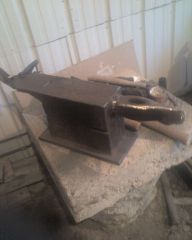
TimB
Members-
Posts
116 -
Joined
-
Last visited
Profile Information
-
Gender
Not Telling
-
Interests
Hunting, Fishing, reloading, muzzle loading, guitar, leathercraft (mostly gun and knife leather) makeing what I need instead of buying it , and teaching my young kids everything I know, just as fast as they will soak it up.
Converted
-
Location
Spokane, Wa.
-
Interests
Hunting, Fishing, reloading, makeing what I need instead of buying it
-
Occupation
Commercial HVAC Service Tech
Recent Profile Visitors
3,437 profile views
-
Forgive me if I'm being slow, but what I'm gathering here is that oxidized metals, (at least Al, and Fe) are harder than the metal is originally---then rusty steel must get weaker due to brittleness of the harder oxidized form? If Al oxide melts at a higher temp than a cutting torch can achieve, and an Al can will scratch a windshield because of its harder Al oxide form, then why will it melt in a campfire that won't melt steel? If a cutting torch can't melt Al oxide, then the blue flame of a furnace burner surely won't either. And no one knows how hard woodpecker lips are
-
Mark, you could check with your local HVAC service company too, especially the ones that work on oil furnaces. We have used a moldable ceramic fiber blanket for years for rebuilding, creating , and lining existing brick combustion chambers. It comes wet, and looks just like a cloth diaper. Once formed into place and fired dry, it is the consistency of Styrofoam, and reflects the heat of the flame back in on itself for efficiency purposes. I haven't used it in this application because I like coal, but it's in the back of my mind to use because coal is getting scarcer for me.
-
What is aluminum oxide? It seems to me that an oxidized form of aluminum wouldn't be hard enough to use as an abrasive for sanding steel--that it would be weaker than aluminum, like oxidized steel is weaker than steel, so I suspect then that what is used as the abrasive on emery cloth is different from how it sounds. Also, sand, when melted, forms glass--an electrical insulator. This could cause a problem if sandpaper were used to polish metal, and sand fragments imbedded in the metal, then it was heated, and the resulting glass insulated the metal electrically---as in an HVAC guy cleaning a flame rod in a residential furnace, with sandpaper, to get a better electrical connection to the flame. He could inadvertently shorten the effective life of the flame rod. Aluminum is not an insulator, so my assumption is that given the same scenario except aluminum oxide abrasive cloth is used, that would not end up also insulating the flame rod. I was told once that it could, but I don't believe that for the above reasons, but I thought I should ask the question to see what you all think.
-
Just about every gas fired furnace nowdays has a flame rod, and as an HVAC/R tech, I've seen many, but lately I been having trouble with a batch of them I got in. The flame rod is nothing more than a metal rod, insulated from ground by a ceramic insulator that also mounts the flame rod, and holds it in the flame of the gas burner. The flame transmits an electric current that the rod picks up and transmits through a wire, back to the ignition module. This is how we prove flame on these such appliances. Anyways, the flame rod is designed to contact the flame, and frequently glows red the entire time the burner is burning. Seldome do we have a problem with these burning in half, or melting, warping, or crystalizing, but on this latest batch, I seem to be having all the above happen. A flame rod that I had installed 2 weeks ago, now has a "plumage" running the 3" of its length. It looks like a bloom, or a small pile of fileings atop a magnetic point on the side of the flame rod. This track can run the length of the rod. My question is, would this be evidence of impurities in the rod, or of improper flame properties, like too little air (May cause a carburizing flame). I don't see any problems with my equipment but I would like to better understand what the rod is telling me.
-
posting pics---for the umteenth time
TimB replied to TimB's topic in Blacksmithing, General Discussion
I did it once and now I can't remember how I did it. (Bill Cosby said that was because of the 8 yr old. ) -
I like that, that's kind of what I plan to do next, and use a vaccume motor / hair dryer, / small blower--- something that uses less electricity than the air compressor.
-
Here's a picture of mine that might spark an idea for you. Since propane tanks are a dime a dozen now since the valve type changed here in the states, (or, like me you had a few laying around anyways). I unscrewed the valve and screwed in a 3/4" nipple, (I'm using compressed air) , but the next one I try, I may cut a 2" hole and use a blower--high velocity / low psi air.
-
Only problem I see is that pile of tackle boxes and fishing poles not doing nuthin. That problem needs resolving. :D
-
posting pics---for the umteenth time
TimB replied to TimB's topic in Blacksmithing, General Discussion
I made him a splitting maul out of a 3# hammer... ...and the first thing he split was the handle. ...overshot the block he was trying to split. Oh well, I've done it too. :unsure: -
In the spirit of blacksmithing, 'er, leastwise just being a tinker w/ lots of junk laying around to entertain myself with... ...my anvill Made from a elevator counterweight, a chunk of red iron I beam, and an old splitting maul head The jumper cable clamp helps with the ring
-
posting pics---for the umteenth time
TimB replied to TimB's topic in Blacksmithing, General Discussion
welll i'll be a .... it worked Thanks Wes -
posting pics---for the umteenth time
TimB replied to TimB's topic in Blacksmithing, General Discussion
testing... My 8 yr old... -
Sorry guys but I gotta ask. I can't find any instruction on posting pictures. I know it's been asked before and I've read it before but I can't find anything. I got my pictures to the gallery so far but can't get them to the thread. How do I do that?
-
Finally got my anvil kinda sorta put together the way I envisioned it with what I had on hand. Works for me so far, but I still need to hard face it, and do some more customizing. Nuts, evidently just "attaching" the picture don't work. I'll try and figure it out.


